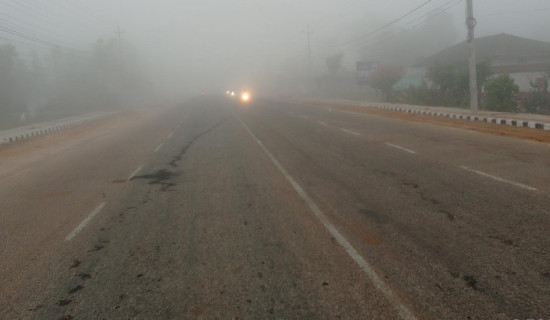- Saturday, 27 December 2025
Plastic Pollution Is Rising
The world is now facing one of the grave environmental problems in plastic pollution. Plastics have become an integral part of human life since they were developed in the 1950s. They have many uses. They are flexible and hence can be moulded into different shapes. They are light in weight. They are resilient. And they are cheap. They produce a smaller carbon footprint than glass, paper or heavy metals do. That is why the use of plastics in the form of various products has grown globally. Despite having beneficial uses, plastics have become a curse as they are a source of environmental pollution. Plastic pollution has affected the water sources all over the world. As per a study, plastic pollution will contribute five to 10 per cent to the greenhouse effect by 2050. When plastic is burned, the gas that is emitted destroys the ozone layer.
The plastics industry is one of the flourishing industries in the world. In 1950, the global production of plastic was two million tons, which had grown to 380 million tons by 2015. With the ubiquitous use of plastics, plastic pollution has spread far and wide to such an extent that microplastics have been found even on Antarctica.
Chemical additives
Plastics can affect the growth of plants by disrupting the process of photosynthesis. Plastics have adverse effects on animals and human health. Being non-biodegradable in nature, plastics remain in the environment for a long time and change into microplastics. They have chemical additives, which are toxic. Such microplastics get into the bodily system through the food chain. Such chemical additives can give rise to cancer and birth defects and impair the immune system.
Plastics have a devastating effect on animals - marine and land animals alike. Plastic pollution is killing marine animals. The food chain in the marine ecosystem has been disrupted owing to plastic pollution. Benthic marine animals are found to have plastic in their bellies. It is reported that 80 per cent of litter enters the oceans from land. Such litter is household waste and factory waste which are poorly recycled, dumped in landfills or in other areas, or left anywhere. On the other hand, plastic pollution is affecting domestic and wild animals. When ingested, plastic affects their bodies.
One of the reasons for growing plastic pollution is the lifestyle of people. People have a perception that plastics are throwaway products. Once used, they are thrown away haphazardly. Plastics are reusable and recyclable products. Rather than throwing away right after use, they can be used for other purposes. They can be recycled into various products such as dustbins, sewer pipes, wiring pipes, garbage bags and bricks. Bricks are made from plastic in Italy.
As per the ICIMOD data, Kathmandu alone uses 4.7 to 4.8 million plastic bags a day. Sixteen per cent of urban waste consists of plastic, which is 2.7 tons of plastic waste produced per day. The government is fully aware of plastic pollution in the country. The government has recently issued a notice against the production, import, sale, distribution and use of plastic bags less than 40 microns in thickness with effect from Bhadra. This provision will be strictly monitored and those violating the provision will face action in accordance with the Environment Protection Act 2076 and the Environment Protection Regulations 2077. There will be monitoring committees at the federal, state and local levels.
This is not, however, a new provision. Way back in 2057 BS, the government made provision for the plastics industry in the country to manufacture or import plastic bags over 20 microns in thickness only. The provision could not, however, be implemented. In 2068 BS, the government issued the directive on the monitoring and control of plastic bags in order to implement the 2057 provision. But this provision came a cropper, too. In 2071 BS, the thickness of plastic bags was increased to 40 microns for the Kathmandu Valley and to 30 microns for districts outside the Valley. Again, the government announced a ban on plastic bags less than 40 microns in thickness from Baisakh 2072 BS. But the Gorkha earthquake that occurred on Baisakh 12 made it difficult to enforce the provision as the government had to engage in post-quake activities.
In Bhadra 2078 BS, the government banned the production, import, sale, distribution and use of plastic bags of less than 40 microns in thickness. An action plan on the ban of plastic bags was formulated in Magh of the same year. However, the provision could not be strictly monitored owing to the COVID-19 pandemic, resulting in the increased production and use of plastic bags
Praiseworthy initiative
So the government was forced to announce this new provision. The government’s initiative in banning plastic bags of less than 40 microns in thickness is praiseworthy. It may, however, be noted that plastic pollution does not lie in ultra-thin plastic bags only. Plastic wrappers used by biscuit, junk food and other industries should also be monitored. Even readymade garments hosiery and other articles of clothing come in plastic wrappers. Such wrappers not only litter the streets but can also clog up the sewerage.
Besides, there should be an awareness campaign on the re-use and safe disposal of plastics. Plastics should also be recycled so that the quantity of garbage will get reduced. The Kathmandu Valley is already in the grip of the garbage problem. The Kathmandu Metropolitan City has not been able to address the garbage problem. It may be hoped that the government will strictly enforce the ban on the production, import sale, distribution and use of plastic bags of less than 40 microns in thickness as there will be monitoring units at the local level. Both the local governments and local people should help the government in implementing the recently announced provision.
(Maharjan has been regularly writing on contemporary issues for this daily since 2000. uttam.maharjan1964@gmail.com)
















